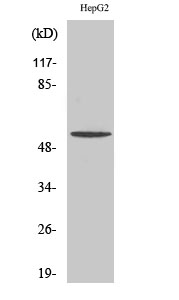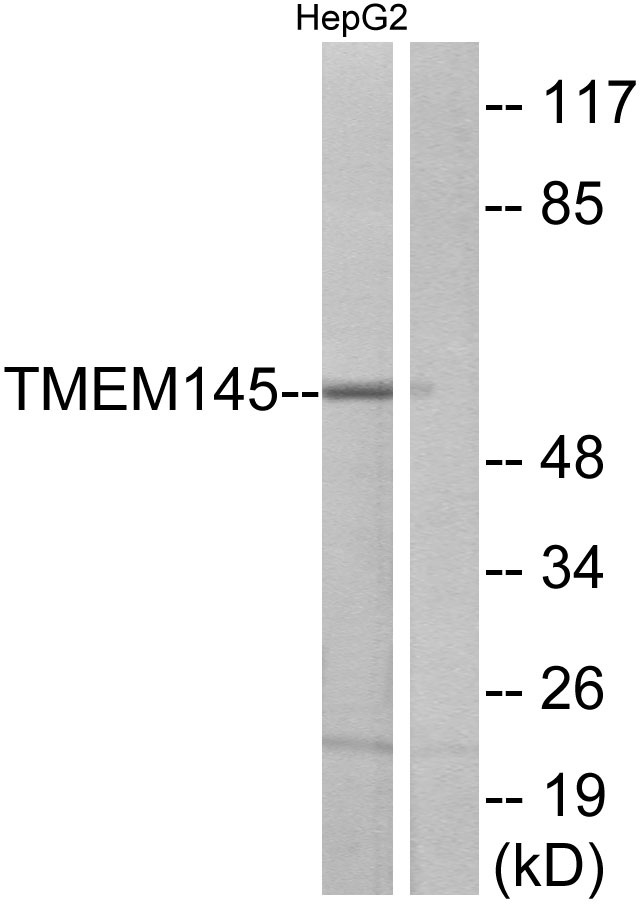TMEM145 Polyclonal Antibody
- Catalog No.:YT4678
- Applications:WB;IHC;IF;ELISA
- Reactivity:Human;Mouse
- Target:
- TMEM145
- Gene Name:
- TMEM145
- Protein Name:
- Transmembrane protein 145
- Human Gene Id:
- 284339
- Human Swiss Prot No:
- Q8NBT3
- Mouse Gene Id:
- 330485
- Mouse Swiss Prot No:
- Q8C4U2
- Immunogen:
- The antiserum was produced against synthesized peptide derived from human TMEM145. AA range:58-107
- Specificity:
- TMEM145 Polyclonal Antibody detects endogenous levels of TMEM145 protein.
- Formulation:
- Liquid in PBS containing 50% glycerol, 0.5% BSA and 0.02% sodium azide.
- Source:
- Polyclonal, Rabbit,IgG
- Dilution:
- WB 1:500 - 1:2000. IHC 1:100 - 1:300. IF 1:200 - 1:1000. ELISA: 1:10000. Not yet tested in other applications.
- Purification:
- The antibody was affinity-purified from rabbit antiserum by affinity-chromatography using epitope-specific immunogen.
- Concentration:
- 1 mg/ml
- Storage Stability:
- -15°C to -25°C/1 year(Do not lower than -25°C)
- Other Name:
- TMEM145;Transmembrane protein 145
- Observed Band(KD):
- 56kD
- Background:
- TMEM145 (transmembrane protein 145) is a 493 amino acid protein encoded by a gene mapping to human chromosome 19. Consisting of around 63 million bases with over 1,400 genes, chromosome 19 makes up over 2% of human genomic DNA. Chromosome 19 includes a diversity of interesting genes and is recognized for having the greatest gene density of the human chromosomes. It is the genetic home for a number of immunoglobulin superfamily members including the killer cell and leukocyte Ig-like receptors, a number of ICAMs, the CEACAM and PSG family, and Fcα receptors. Key genes for eye color and hair color also map to chromosome 19. Peutz-Jeghers syndrome, spinocerebellar ataxia type 6, the stroke disorder CADASIL, hypercholesterolemia and insulin-dependent diabetes have been linked to chromosome 19. Translocations with chromosome 19 and chromosome 14 can be seen in some lymphoproliferative disorders and typically involve the proto-oncogene BCL3.
- Subcellular Location:
- Membrane ; Multi-pass membrane protein .
- Expression:
- Retinoblastoma,
- June 19-2018
- WESTERN IMMUNOBLOTTING PROTOCOL
- June 19-2018
- IMMUNOHISTOCHEMISTRY-PARAFFIN PROTOCOL
- June 19-2018
- IMMUNOFLUORESCENCE PROTOCOL
- September 08-2020
- FLOW-CYTOMEYRT-PROTOCOL
- May 20-2022
- Cell-Based ELISA│解您多样本WB检测之困扰
- July 13-2018
- CELL-BASED-ELISA-PROTOCOL-FOR-ACETYL-PROTEIN
- July 13-2018
- CELL-BASED-ELISA-PROTOCOL-FOR-PHOSPHO-PROTEIN
- July 13-2018
- Antibody-FAQs
- Products Images

- Western Blot analysis of various cells using TMEM145 Polyclonal Antibody. Secondary antibody(catalog#:RS0002) was diluted at 1:20000

- Western blot analysis of lysates from HepG2 cells, using TMEM145 Antibody. The lane on the right is blocked with the synthesized peptide.



